#Panama Fleets
Text
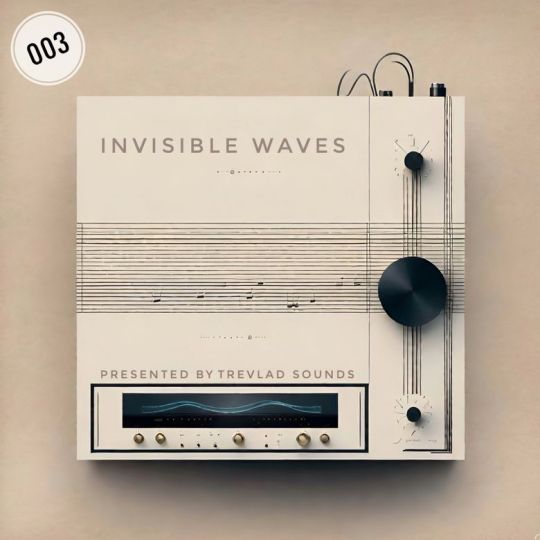
Intro. 00:00
Wojciech Golczewski-Otherworld 00:41
Survey Channel-Moss Tilt 03:39
Subphotic-The Sitting Tree 05:12
Chapter 1 12:26
Drapizdat, Reather Weport-Pattern #5 14:59
Minimal Drone*GRL-Lady Of The Mountains 17:56
Hyperlink Dream Sync-Galaxy Structure 22:42
MiDi BiTCH-Unearthly 26:48
Panama Fleets-Zealandia 31:25
Abu Ama + BedouinDrone-Leptis Magna 35:41
Chapter 2 49:03
Lo Five-Unbecoming You 50:58
Time Rival-Redox 55:41
Eje Eje-Saved From The Jazz (Spring) 58:26
Hello Meteor-Waterproof Thoughts 1:01:57
S U R V I V E-Hourglass 1:05:28
Depeche Mode-Don't Say You Love Me 1:09:48
Chapter 3 1:13:19
Vic Mars-Holloways 1:14:59
Pabellón Sintético-Ludwing 1:19:32
Joel Grind-Fallen Metropolis 1:28:27
ATA Records-Pineapple Diode Daiquiri 1:32:18
Mary Lattimore, Roy Montgomery-Blender in a Blender 1:34:45
Off Land-Numbers Station 1:41:04
Chapter 4 1:47:42
Robohands-Palms 1:49:33
Conflux Coldwell-Earth Sea and Sky 1:52:17
Outro 5 1:57:20
Album of background soundscapes by me
#Wojciech Golczewski#Invada#Survey Channel#Music Is The Devil#Subphotic#Drapizdat#Reather Weport#Not Not Fun Records#Minimal Drone*GRL#Bricolage#Hyperlink Dream Sync#Fonolith#business casual#MiDi BiTCH#Cyclical Dreams#Panama Fleets#Abu Ama + BedouinDrone#Mahorka#Unexplained Sounds Group#Lo Five#Castles in Space Subscription Library#Castles In Space#Time Rival#Triplicate Records#Eje Eje#Batov Records#Hello Meteor#S U R V I V E#Holodeck Records#Depeche Mode
3 notes
·
View notes
Text
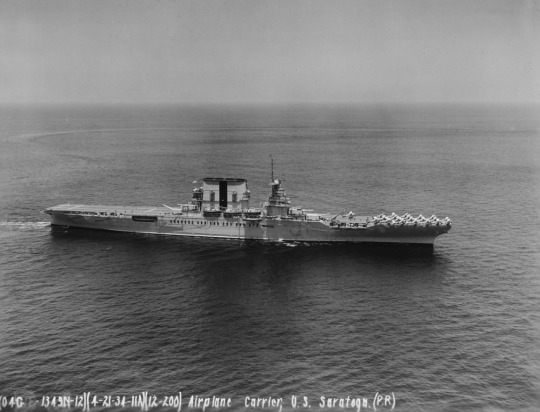
USS SARATOGA (CV-3) operating off Panama during Fleet Problem XV.
Date: April 21, 1934
U.S. Naval History and Heritage Command: NH 93557
#USS Saratoga (CV-3)#USS Saratoga#Lexington Class#Aircraft Carrier#Fleet Problem XV#Panama#Pacific Ocean#April#1934#interwar period#united states navy#us navy#navy#usn#u.s. navy#my post
61 notes
·
View notes
Text

The Longest Way Round Is the Shortest Way There - an Object Lesson For U.S.
December 29, 1907
Neptune Bob Evans maps out his journey to get around South America, where a sign shows that it's 4,000 miles to Magdalena Bay by the Panama Canal, which has no thorofare, or 14,000 miles to go all around South America.
He comments to Uncle Sam 'Now if I could duck thru the Panama canal I could save some 10,000 miles and some other things like coal and time'.
Robley D. Evans was the commander of the 'Great White Fleet' a massive US fleet on a round the world mission. To get to the Pacific Ocean, he was forced to sail around South America, as the Panama Canal was still under construction.
See Also: Panama Canal
From Hennepin County Library
Original available at: https://digitalcollections.hclib.org/digital/collection/Bart/id/6097/rec/1824
#charles bartholomew#political cartoon#american history#panama canal#great white fleet#robley evans#uncle sam
0 notes
Photo
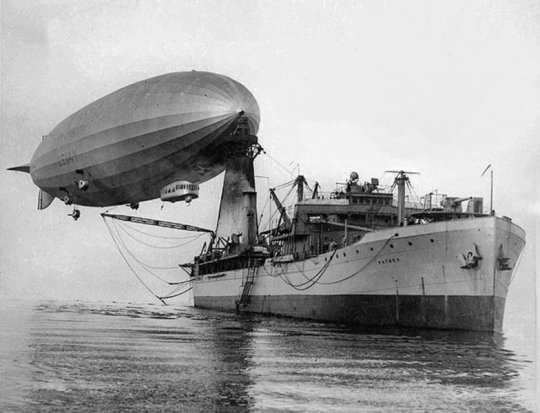
USS Los Angeles (ZR-3) moored to USS Patoka (AO-9) off Panama during Fleet Problem XII, February 1931
583 notes
·
View notes
Text
my friend, a casual ofmd enjoyer, displaying a level of media literacy to which the canyon could never ascend: it's too bad we didn't get more of zheng. She's awesome. Of course, she's not the main character
true, true. But of course zheng is awesome and deserves an appreciation post. so.
an incomplete list of reasons why zheng yi sao, ofmd edition, rules:
is all about the soup
negotiates a living wage for her crew
morning tai chi and eucalyptus towels
is soft for oluwande (demonstrates excellent taste and judgement)
is really very chill about the whole “escaped my prisoners and ran off with my ship’s wheel” thing when she sees the revenge crew again
only tries to kill stede once and only after he was really asking for it
“pirate queen who bent china to her will”
super generous with the soup actually
“girl, how are you”
walks her fleet across panama. given time she probably could have built the canal
“culturally this must be very difficult for you”
kills a guy with acupressure points (r.i.p. steak knife)
“this is a join me or die situation”
pigtails
her cover as soup-kiosk sue was so good not even jackie clocked her real identity
“guys! fuck!”
member of the (100% canon and non-negotiable) tealoranges extended polycule
kills men whether they are exceptional or just mediocre (r.i.p. exceptional men)
“i know. it’s been a day” (most quotable character fr)
the red flag seems like a great place to be a pirate actually. cute uniforms with a great fit, collaborative atmosphere, soup.
soup
151 notes
·
View notes
Text


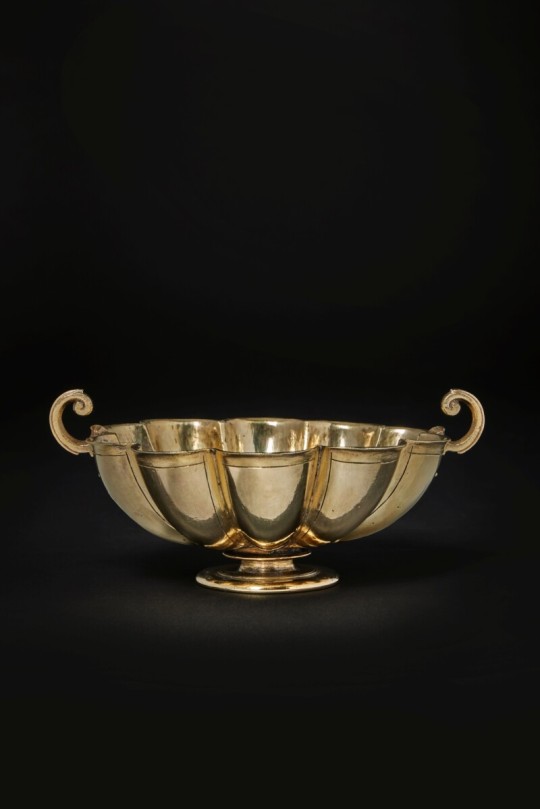
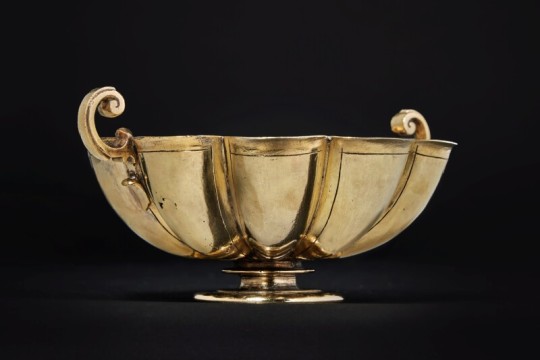
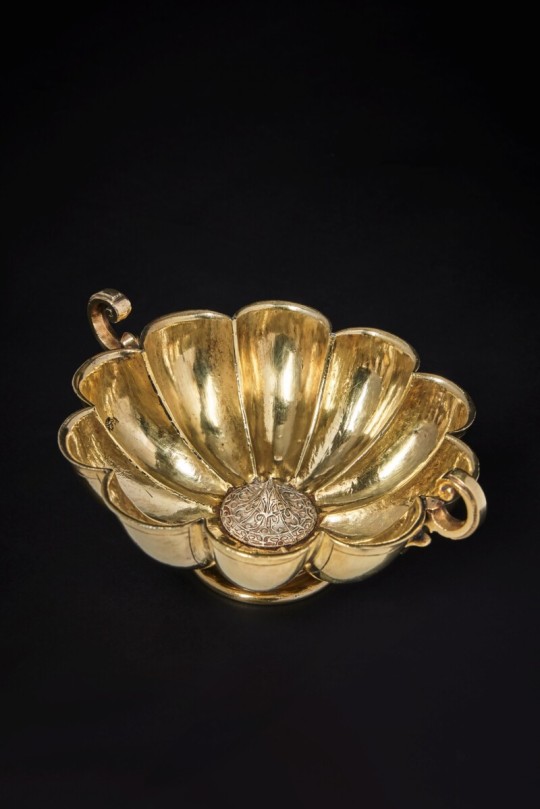
A Rare Spanish Colonial Silver-Gilt Two-Handled Cup from the Atocha Shipwreck
Bogotá, Colombia, circa 1620
Nuestra Señora de Atocha was a Spanish treasure galleon and the most widely known vessel of a fleet of ships that sank in a hurricane off the Florida Keys in 1622. At the time of her sinking, Nuestra Señora de Atocha was heavily laden with copper, silver, gold, tobacco, gems, and indigo from Spanish ports at Cartagena and Porto Bello in New Granada (present-day Colombia and Panama, respectively) and Havana, bound for Spain. The Nuestra Señora de Atocha was named for the Basilica of Nuestra Señora de Atocha in Madrid, Spain. It was a heavily armed Spanish galleon that served as the almirante (rear guard) for the Spanish fleet. It would trail behind the other ships in the flota to prevent an attack from the rear.
Much of the wreck of Nuestra Señora de Atocha was famously recovered by an American commercial treasure hunting expedition in 1985. Following a lengthy court battle against the State of Florida, the finders were ultimately awarded sole ownership of the rights to the treasure.
#A Rare Spanish Colonial Silver-Gilt Two-Handled Cup from the Atocha Shipwreck#Bogotá Colombia#circa 1620#Atocha#Nuestra Señora de Atocha#Spanish treasure galleon#treasure#shipwreck#silver#ancient artifacts#archeology#archeolgst#history#history news#art#antique
68 notes
·
View notes
Text
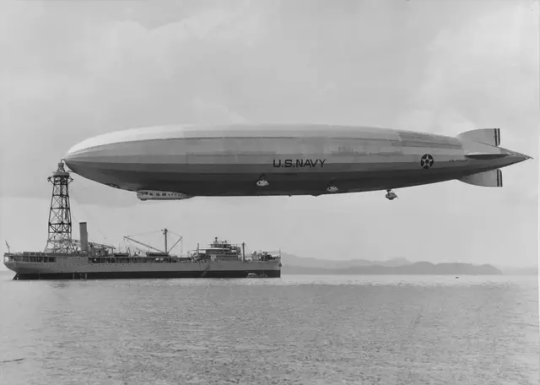
The Zeppelin Company-built airship USS Los Angeles (ZR-3) hovers moored to USS Patoka (AO-9), off Panama during US Naval exercise “Fleet Problem XII”, February 1931.
55 notes
·
View notes
Text
last season Zheng Yi Sao (conquered China, massive fleet) heard people say Blackbeard (conquered nothing, no fleet) was the best pirate of all time and got so irritated she decided to drag a fleet of ships across Panama about it.
#like this is not her motivation but could you imagine if it was#the 'Blackbeard is the best pirate of all time' stuff is so funny when you consider she was just an ocean away in the ofmd timeline#my nonsense#our flag means death#ofmd s2#zheng yi sao ofmd
92 notes
·
View notes
Text

The USS South Dakota (BB-57) left California on her final Pacific voyage. She transited through the Panama Canal, and arrived at the Philadelphia Naval Shipyard on 20 January for a yard overhaul. In June of the same year she was attached to the Atlantic Reserve Fleet. On 31 January 1947, she was decommissioned and placed in reserve status.
Photo- The SOUTH DAKOTA arrives at the Philadelphia Naval Shipyard on 20 January 1946.
61 notes
·
View notes
Text

Some of the Oyster World Rally fleet in the San Blas Islands, Panama.
43 notes
·
View notes
Photo

The Capture of the Treasure Ship Madre de Deus
The treasure ship Madre de Deus (aka Madre de Dios) was a Portuguese vessel carrying hugely valuable cargo from the East Indies which was attacked and captured by a fleet of English privateers in the Azores in September 1592 CE. The ship, packed full of jewels, pearls, gold, silver, ebony, and spices, was the richest prize ever taken by the privateers who plundered the Atlantic during the long reign of Elizabeth I of England (r. 1558-1603 CE). The capture was masterminded by Sir Walter Raleigh (c. 1552-1618 CE), and the £80,000 return on Elizabeth's £3,000 original investment helped repair relations between the adventurer and his queen, securing his release from the Tower of London. The fabulous treasure inspired many more privateering fleets to prowl the seas but none would ever make a capture as rich as the Madre de Deus.
Walter Raleigh
Although once a firm favourite of Queen Elizabeth, Walter Raleigh had fallen out with his monarch when she discovered the courtier and adventurer had secretly married one of her ladies-in-waiting, Elizabeth 'Bess' Throckmorton (1565-1647 CE). Raleigh was imprisoned in the Tower of London for his impudence in August 1592 CE. Fortunately, Raleigh had already organised a fleet to capture treasure ships of Philip II of Spain (r. 1556-1598 CE), and the unimaginable success it gained would be his ticket to freedom.
In the Elizabethan age privateers were sailors and adventurers who scoured the Caribbean and Atlantic for treasure ships carrying valuable cargo from the New World and Asia to Europe. Elizabeth often invested personally in these expeditions, and the spoils were shared according to the amount she and other investors had made in the project. Consequently, both the privateers and the state coffers were enriched by a practice which correspondingly depleted the wealth of England's great enemy: Philip II of Spain.
Raleigh had intended to command his latest privateer fleet personally but he was recalled to London the day after he set sail on 6 May 1592 CE. The queen had discovered his secret marriage and Raleigh was replaced as commander of the fleet by Martin Frobisher (c. 1535-1594 CE). Raleigh dithered but after two weeks he did return to London and captivity.
Backed by investors which included the queen, George Clifford, the Earl of Cumberland, a consortium of merchants and Raleigh himself, the fleet was well-equipped. The original plan was to sail for the Isthmus of Panama and attack the annual treasure fleet which sailed from the Americas to Spain laden with gold, silver, and other loot. First, though, they sailed to Spain and then divided, Frobisher taking some ships to Cape St. Vincent in southern Portugal while the remainder headed for the Azores in the mid-Atlantic. This latter group was commanded by Sir John Burgh and was reinforced by the arrival of six more ships sent by the Earl of Cumberland. Burgh arrived in the Azores on 21 June where, to his chagrin, he discovered he had already missed the first ships due in from the East Indies.
Continue reading...
30 notes
·
View notes
Text

Saturday 09 December Mixtape 403 “Night Rolls EXCLUSIVE”
Multi Genre, Downtempo, Ambient, Electroacoustic, Experimental
Tuesdays & Saturdays.
Support the artists and labels.
Don't forget to tip so future shows can bloom.
Trevlad Sounds-Welcome in you wonderful listener 00:00
Gregg Kowalsky-Nights Move 00:31
Suzanne Ciani, Jonathan Fitoussi-Coral Reef 04:50
Drapizdat, Ито Кумаре-Сквозь Зазеркалье 09:03
Synthotherapy-It Takes A Long Time 12:25
Anantakara-Letting Go, Finding Light 16:57
Tarotplane-Descartes Camera 24:02
Thought Bubble-Devoider 27:31
Panama Fleets-Laguna Oscuramaru 33:43
Time Rival-Electronegative 38:24
Sven Wunder-Lunar Distance 43:50
Futuregrapher-Moog Meditation 3 47:45
F.U.S.E., Richie Hawtin-Nitedrive 56:40
Robohands-Jorge 59:50
Field Lines Cartographer-The Nest 1:03:01
Mary Lattimore, Roy Montgomery-Blender in a Blender 1:11:10
Subphotic-The Sitting Tree 1:17:18
36-Blow Out 1:24:15
Roy Werner-Late Chime 1:27:50
Actress-Chill ( h 2 ) 1:31:04
André 3000-The Slang Word P( )ssy Rolls Off The Tongue With Far Better Ease Than The Proper Word Vagina . Do You Agree 1:32:01
Burial Grid-The Woman Buried Beneath the Candle 1:44:04
Michael Brückner-Claudette 1:47:14
Survey Channel-Moss Tilt 1:54:36
#Gregg Kowalsky#Mexican Summer#Suzanne Ciani#Jonathan Fitoussi#Transversales Disques#Drapizdat#Ито Кумаре#Not Not Fun Records#Synthotherapy#Moolakii Club Audio Interface#Anantakara#Cyclical Dreams#Tarotplane#Thought Bubble#echodelickrecords#Panama Fleets#Sparkwood Records#Time Rival#Triplicate Records#Sven Wunder#Piano Piano Records#Futuregrapher#Móatún 7#F.U.S.E.#Richie Hawtin#Warp#Robohands#Bastard Jazz Recordings#Field Lines Cartographer#Woodford Halse
3 notes
·
View notes
Text


USS Texas (BB-35) docked at Balboa, Canal Zone, Panama, during Fleet Problem IX.
"The 'Enemy' takes possession of the Panama Canal. USS Texas (BB-35), flagship of the Commander of the US Fleet, moored to the dock at Balboa, Canal Zone, after successfully, theoretically, capturing the Panama Canal during the recent war manoeuvres."
Date: February 16, 1929
source, source
#USS Texas (BB-35)#USS Texas#New York Class#Battleship#Dreadnought#Battleship Texas#Warship#ship#Fleet Problem IX#Balboa#Canal Zone#Panama#United States Navy#U.S. Navy#US Navy#USN#Navy#February#1929#interwar period#my post
11 notes
·
View notes
Text
Caribbean cruise vacations have a long violent history. Earlier today, I came across one of the early print advertisement illustrations for the Caribbean cruise ship vacations offered by “the Great White Fleet.” And I pondered bananas.
Just as uncomfortable as it sounds. The story of the origin of the Caribbean cruise industry is, after all, also the story of the origin of the term “Banana Republic.”
In 1914, the Great War began as the planet’s powerful empires of old were collapsing, as British, French, Austro-Hungarian, Ottoman, Russian, and Qing/Chinese powers were marred by internal revolt and global warfare. But in 1914, the United States completed their Panama Canal and consolidated power in Latin America and the Caribbean, celebrating the ascent of a “new” empire made strong, in part, by bananas.
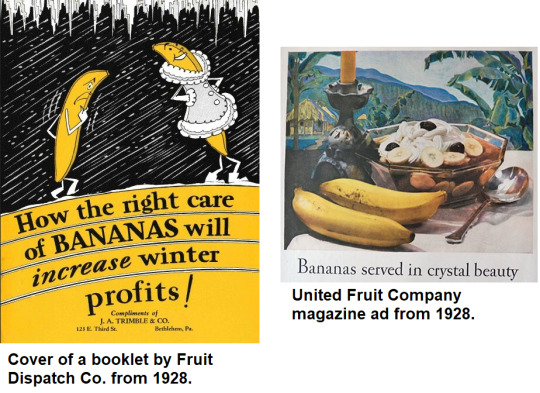


As of 2022, bananas generate 12 billion dollars per year, with 75% of bananas exported from Latin America and the Caribbean.
The planet’s single biggest banana-producing company is Chiquita. The Chiquita brand was previously known as United Fruit Company, which had essentially monopolized the banana industry in Latin America. United Fruit Company has a bit of an image problem, following its theft of Indigenous land across Central America in the early 20th century; its role in provoking the killing of tens of hundreds/thousands of plantation laborers during the Banana Massacre of 1928; the company’s direct role in the CIA-backed toppling of the Guatemala government in the 1950s; and the company’s role in paying to harass and intimidate labor organizers in Colombia in recent decades.
But what of the “romance” and “adventure” of the Caribbean?
So it’s 1915 or 1916.
Middle of the Great War. Classic empires are disintegrating: Spanish empire, British empire, Austro-Hungarian empire, Russian empire, Ottoman empire, remnants of the Qing/Chinese state, etc. And whose empire is rising? United States, an empire expanding in the Caribbean, Central America, and South America. After the 1898 Spanish-US war, as Teddy Roosevelt’s cartoon cavalry conquered Cuba, the Spanish Main belongs to the US of A. The US Navy controlled the Caribbean Sea, and was aiming to expand across the Pacific Ocean, to Hawai’i and beyond.
But the official US Navy isn’t the only fleet upholding the empire. The United Fruit Company had its own fleet.
The text of one of these Great White Fleet ads, from 1916, adorned with imagery of a blue-and-gold macaw and an aerial map of the Caribbean, reads:
“[W]here winter never comes and where the soft trade winds bring renewed health. [W]ith all the comforts and all the luxuries of life you enjoy aboard the palatial ships of the GREAT WHITE FLEET. Delicious meals a la carte [...]. Dainty staterooms, perfectly ventilated [...]. [A]mid the scenes of romance and history in the Caribbean. And with it the opportunity to win for yourself a treasure of health and happiness, of greater benefit than the fabled fountain of youth, sought by Spanish adventurers in the tropic isles of the Spanish Main.”
Who’s leading the charge?
The United Fruit Company!

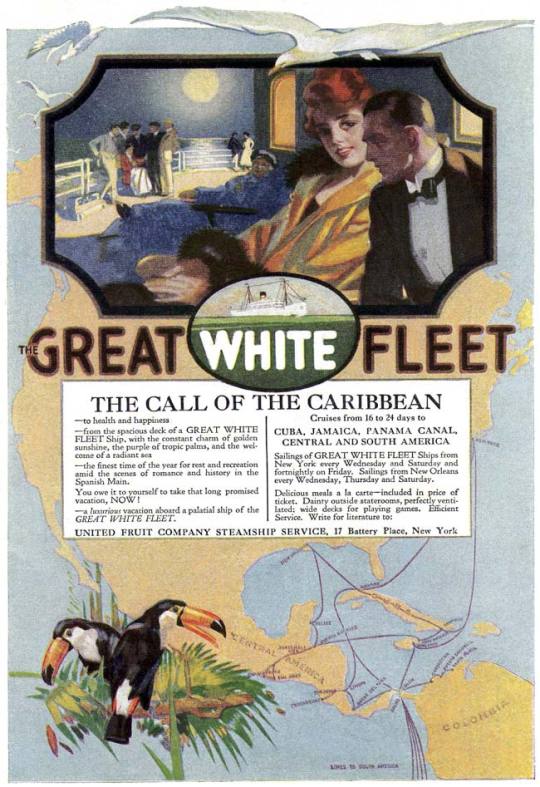
From the May 1916 issue of Red Book. Image source, from Archive dot org:
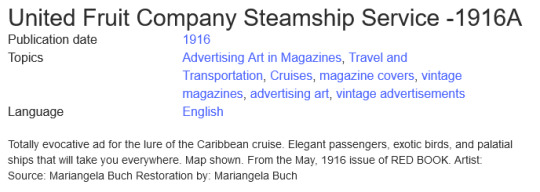
Another:
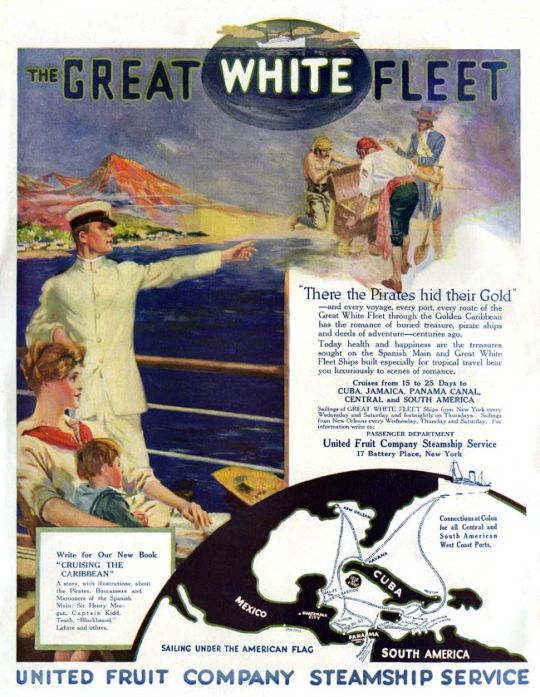
Image source, from Archive dot org:

“There the Pirates hid their Gold -- and every voyage, every port, every route of the Great White Fleet through the Golden Caribbean has the romance of buried treasure, pirate ships an deeds of adventure [...].”
The Golden Caribbean.
The same region where Columbus murdered Indigenous people, where the US and France had just spent 100 years punishing Haiti with unending economic warfare afters slaves rebelled against colonization, and where the United Fruit Company would now set up shop.
The company’s plantations would expand across Central America, establishing brutal racial hierarchies and essentially controlling federal governments of Central American nations.
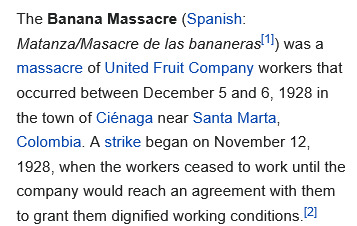
In 1928, over 30,000 laborers were on strike at banana plantations in Colombia. They demanded payment of actual wages, rather than the credits they were given which were mostly only redeemable at company-owned stores in company towns. The US government threatened to send the Marine Corps to intervene if the “subversive” workers would not return to UFC’s plantations. In December 1928, after martial law had been declared, General Cortes Vargas entered the town square of Cienaga (Magdalena) during Sunday gatherings, with machine guns, opening fire on the crowds, and killing perhaps 3,000 people.
In the late 1940s, the United Fruit Company intensified its ad campaigns led by propagandist Edward Bernays (nephew of Sigmund Freud???), who also practiced his skill at manipulative advertising when working to popularize the American Tobacco Company by showing women smoking “torches of freedom” and linking “women’s rights” to cigarette iconography.
Bernays, who explicitly wrote about his “counter-Communist” intention in the ads, was “drafted” in the war to topple ascendant leftist governments. After 1944 and after Arevalo’s labor reforms, Jacobo Arbenz Guzman took control of Guatemala in 1951, and took over 200,000 acres from United Fruit Company and returned them to poor families. Bernays launched propaganda attacks against Guatemala, helping to plant stories about Guatemala eventually carried in the Saturday Evening Post, New York Herald Tribune, and Reader’s Digest. In January 1952, Bernays personally led a tour of Central America, accompanying publishers and editors of Newsweek, the Miami Herald, the San Francisco Chronicle, the Cincinnati Enquirer, Scripps-Howard, and Time magazine. When the CIA-trained military force led by Carlos Castillo Armas invaded Guatemala, with CIA aerial support, installing Castillo Armas as president, Bernays called them an “army of liberation.”

Bananas and Caribbean cruises aren’t the only culprits in expanding imperial power in Latin America, the tropics, and the Global South.
In 1914, the same year that the United States finished the Panama Canal and consolidated power in Latin America and the Caribbean, Richard Strong was a newly appointed director of Harvard’s new Department of Tropical Medicine. Strong was also appointed director of the Laboratories of the Hospitals and of Research Work at United Fruit Company. Strong toured the company’s plantations in Panama, Costa Rica, Guatemala, Honduras, and Cuba. In the coming years, Strong would also personally approach Harvey Firestone, chief executive of the Firestone company, which owned and brutally operated rubber plantations in tropical West Africa. Research in tropical medicine was thus inaugurated by and dependent on colonial/imperial plantations and racial/social hierarchies at United Fruit Company and Firestone sites across the tropical regions, planetwide. Strong is just one character that demonstrates the interconnectedness of academia, fruit plantations, rubber supplies, food distribution, motor vehicle industries, strike-breakers, military forces, imperial expansion, and other tendrils of violently-enforced racist power.
Today, in 2022, Chiquita maintains twenty thousand employees across 70 countries.
I think about this as I eat a banana for lunchtime. I think about this when I see the Edenic portrayal of a Caribbean shore, a landscape baked not so much by the tropical sun but instead scarred by centuries of genocide, slavery, and plantation labor, where government officials gleefully report “with honor” on the massacre of thousands.
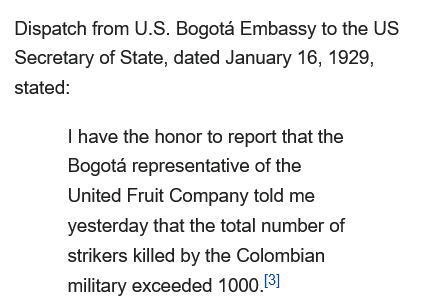

“Just a banana, it ain’t.”
Agreed.
336 notes
·
View notes
Text
Pull! And pull!
In "Red Flags," the ending montage over "Run From Me" is mostly about the mutiny Ed's been trying to provoke, and Ed's crew deciding to kill him. And it's devastating. But the short interpolation of Auntie standing up, resolute and focused, over her map, and Red Flag fleet members pulling ships over land in pre-canal Panama is goosebump city for me every time.
It gets at a whole bunch of stuff about Zheng and her crew very efficiently: the will and the effort and leadership involved in being the pirate queen who conquers China, for one. This brief moment pays off Oluwande thinking that Auntie's map can't mean anything because some of the ships are on land. It very effectively shows how massive the fleet is. It highlights why Zheng was talking about how important cohesion is to the ship's culture. The incongruity of seeing crew members haul those immense ships through a forest track ... it's a few precious beats of awe while most of my heart is still breaking for Ed and his crewmates.
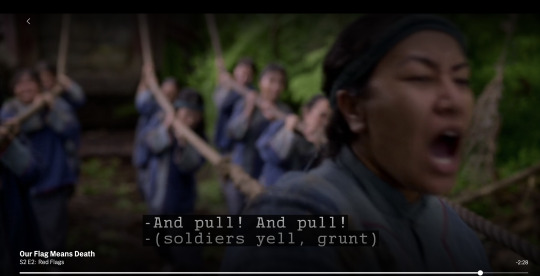

#pull! and pull!#do i say this to myself sometimes when i am walking into the wind on my way to the train station on an especially rainy day? yep#red flag fleet#ofmd s2e2#zheng yi sao#red flag crew
16 notes
·
View notes
Text
I have been so busy, that I forgot to post this one and just found it in my drafts.
I don't know if anyone noted this or posted this before, but I had to screen grab one particular scene from S2 of Our Flag Means Death.
So there were these commercial, colonial roads laid out through the Isthmus of Panama, known as Camino Real de Cruces, to carry wealth from one coast to the other, transported on foot, by mules, and by boat in some parts where the road met the river Chagres. In the mid to late 1600s and early 1700s, Panama was attacked a lot by pirates, including and most famously by Henry Morgan, so the routes had to change, but they were all basically where the Panama Canal is now, the narrowest part of the country, and thus the narrowest passage from one ocean to the other.
But David Jenkins decided that Zheng Yi Sao's fleet created the first Panama Canal:

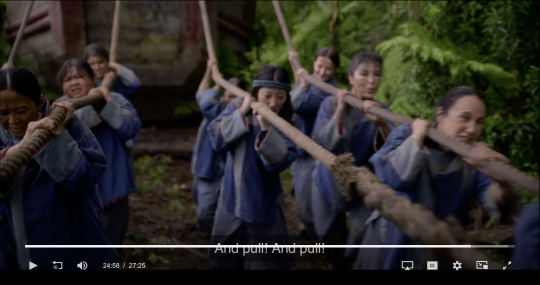

I'm willing to accept this as historical fact.
21 notes
·
View notes